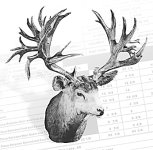Yes, it's a Deer. Yes, it's a Whitetail. It is what is correctly as "Non-Typical" which does not show typical or normal growth characteristics. There are Non-Typical Mule Deer that have a lot more points, and look a lot stranger than that one.
9c1Lover,
A 36 point Deer is quite possible, although it would have to fall into the Non-Typical category. "Points" on Deer are calculated differently depending on species.
Mule Deer are calculated based on point count on one side. If the Deer has 6 points on both sides it is referred to as a 6-point. If more on one side then it would be described as a 6x5, 3x2, etc. This is called "Western Count". To be counted a point must extend 1" or more from the main beam.
Whitetail Deer are scored by what is called "Eastern Count", all points on both sides added together. Because of the background I can't say what the "count" for the Deer in the photo would be, I can't see it well enough.
For some reason I can't get photos to attach from my computer, but go to this site
Boone and Crockett Club and scroll down to "Worlds Record Non-Typical Mule Deer", pictured is a
22x21 point (total 43 points) Mule Deer killed in Alberta Canada. The Boone & Crockett Club is the official record-keeping organization for North American Big-Game record date. So, you see, 36 points is not at all impossible, although exceedingly rare.
Typical and Non-Typical Deer records are kept as separate records since they are not directly comparable.
Guess this time it worked! Looks like a shrub on his head, doesn't it?!
JKC,
You are talking about "scoring points", the aggregate of specific dimensions measured from the antlers. A 6 "Point" buck may score 185 scoring points, but conversationally it would be referred to as a "6 Point", not a 185 point deer. No one ever refers to an animal by it's record book score when referring to points, but rather "Point count" literally the number of individual tines over 1" long on the antlers. Definitely an apples and oranges comparison don't you think?
The pictured Mule Deer scored 355 2/8. Wouldn't it sound silly to call it a 355 2/8 point deer in casual conversation? The scoring points do not give any indication at all how many "Points" (tines) the Deer had on it's antlers.



